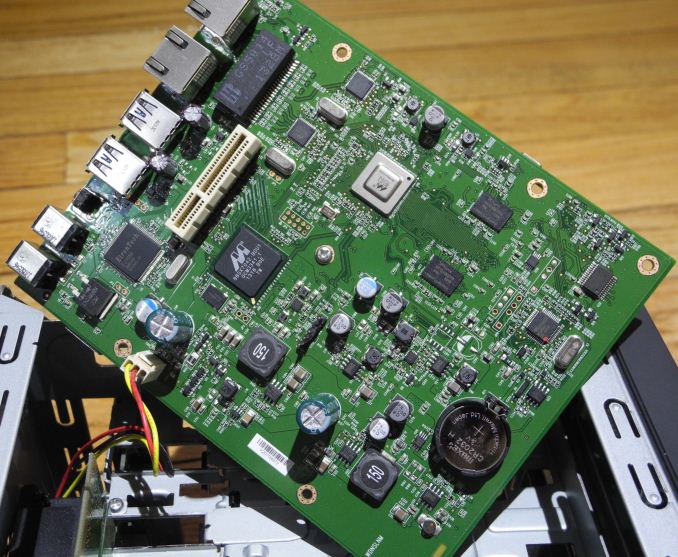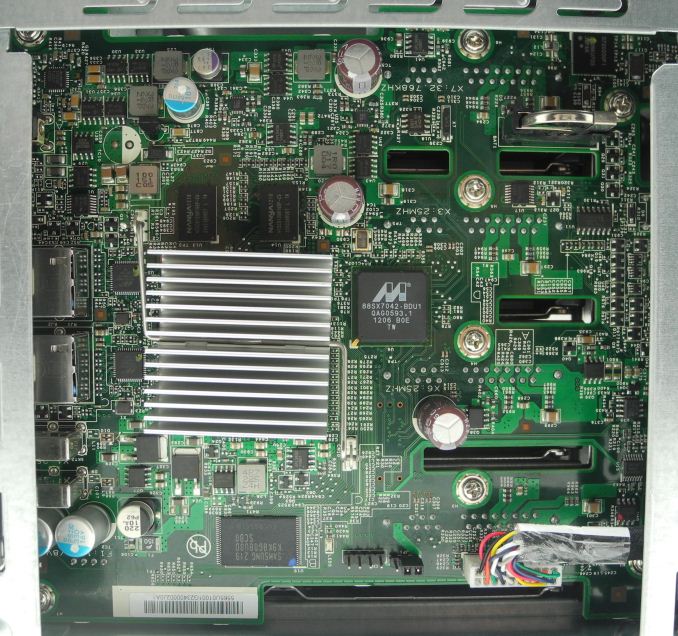Western Digital My Cloud EX4 and LenovoEMC ix4-300d Home NAS Units Review
by Ganesh T S on February 26, 2014 2:30 AM EST- Posted in
- NAS
- Western Digital
- LenovoEMC
Teardown and Platform Analysis
The internal specifications, as well as the available I/O ports, of the LenovoEMC ix4-300d and the Western Digital My Cloud EX4 were tabulated in the previous page. Both the NAS units come with 90W power bricks (100 - 240V AC-in, 19V @ 4.7A DC-out). Despite having two GbE ports, only one RJ-45 cable is supplied in each package. While the EX4 doesn't have any I/O ports in the front, the ix4-300d has a USB 3.0 port beneath the power button. Moving to the rear, the WD EX4 has two power jacks, two USB 3.0 ports, a recessed reset button and two GbE ports at the top. Perforations for a single large fan make up the lower segment. On the other hand, the ix4-300d has two USB 2.0 ports, two GbE ports, a recessed reset button and the DC jack on the left side of the rear face, while a single large fan makes up the right side.
On the i4-300d, the chassis cover has to be removed in order to add or replace hard drives. This is an acceptable solution since the unit doesn't have hot swap capability. The drive caddy is interesting in the sense that the hard drives don't need to be secured with screws. Rather, the caddy has 'screws' which slot into the appropriate drive holes. The caddies have to be pulled out with force, and the whole drive addition / replacement experience, though fast, is not entirely a pleasant one. It would be preferable to have a traditional caddy to support both 2.5" and 3.5" drives. The EX4, on the other hand, completely does away with the caddies. The hard drive slots are sized exactly to fit in a 3.5" drive in the correct orientation. There are no drive caddies or screws to bother with. Despite the Marvell ARMADA XP in the ix4-300d being clocked only at 1.3 GHz and the Kirkwood SoC in the EX4 being clocked at 2.0 GHz, it is the ix4-300d which has a heatsink on top of the SoC. The EX4 just opts for open air cooling.
Western Digital My Cloud EX4 Motherboard
The Marvell 6282 is a well-known entity in NAS circles. We have seen its 1.6 GHz lower-clocked cousin in the Synology DS211+ and the Netgear NV+ v2. As a recap, the SoC configuration of the 6282 is provided below.
Marvell Kirkwood 6282 Block Diagram
The WD EX4 has two GbE ports, and we can see that the 6282 has two native GbE MACs on-board. The other interesting components on the board are the Marvell 88SX7042 (4-port SATA to PCIe x4 bridge), the Etron EJ168A (2-port USB 3.0 to PCIe x1 bridge) and two Marvell 88E1518 GbE transceivers. Even considering the fact that the SATA SERDES lanes on the 6282 were reconfigured for PCIe (unlikely, since there is no reference in the Marvell documentation to that being possible), we are left with an imbalance: A total of five PCIe lanes are needed for the peripherals, while the SoC only provides two. It is simply not possible for the system to support all peripheral I/Os are full speed. What does this have on routine performance? We hope to address this in the performance sections of the review.
Moving on to the ix4-300d, we find it to be based on a dual-core Marvell ARMADA XP dual-core solution, the Marvell MV78230. A block diagram of the high-end ARMADA XP solution is given below.
Marvell ARMADA XP Block Diagram
The main difference between the MV78230 solution and the 78460 represented above are the number of cores (2 instead of 4 v7 CPUs), core frequency (1.3 GHz instead of 1.6 GHz), L2 cache size (1 MB instead of 2 MB), DRAM buswidth (32 instead of 64), number of GbE ports (3 instead of 4) and number of SERDES lanes (7 instead of 16). A photo of the main components of the ix4-300d motherboard is shown below.
LenovoEMC ix4-300d Motherboard
The Marvell 88SX7042 SATA to PCIe bridge again makes an appearance. The four SATA ports connect to the daughterboard and interface with the disks in the drive bays. On the other side, this bridge connects to four SERDES lanes (configured as PCIe) on the MV78230. On the top right of the picture above, a Renesas µPD720200A USB 3.0 to PCIe 2.0 x1 bridge can be seen. It takes up one more SERDES lane. This still leaves a couple of spare SERDES lanes, as the only other I/Os (two USB 2.0 ports and two GbE ports) have direct interfaces on the SoC. On the whole, the platform design of the ix4-300d seems to be able to guarantee exploitation of the full performance from all connected peripherals simultaneously. The performance sections will prove whether the inferences from the board design translate to performance in real-world situations also.


























38 Comments
View All Comments
OoKiE69 - Wednesday, February 26, 2014 - link
Having owned a LenovoEMC ix4-300d for two months before returning it, I am surprised to see that your review does not mention the intermittent slow downs experienced. Or flagging perfectly good disks as failed. Or the random dropping of all your data on a RAID 10 configuration. This really annoying considering it takes over a day to establish the raid 10 on 4 x 3TB drives. None of these faults even generate a single email alert. Yes the email alerting was configured and tested.Despite claiming Full Windows 8 compatibility, it's not. None of the shares can be added to a library without a bit of fudging under the hood. Even with the fudging done it doesn't work with any of the Modern UI applications.
Fortunately a HP Micro Server and a license for Home Server 2011 all for just a little bit more money seems function with the same hard drives in RAID 10 without a single issue and fast. In short I found LenovoEMC ix4-300d NAS to be just really bad.
ganeshts - Wednesday, February 26, 2014 - link
What was the firmware version you used before sending back the unit ? I had lots of trouble with 3.x and even the first 4.x version (documented with links tot he support forums in the article under the ix4-300d: Springing Surprises sub-section). However, with the November firmware release, things have improved quite a bit. Still not trusting the NAS with any essential data, though.crazysurfanz - Wednesday, February 26, 2014 - link
Quote: Still not trusting the NAS with any essential data, though.Really isn't much more that needs to be said about it then is there.
Bob Todd - Thursday, February 27, 2014 - link
If you don't mind rolling your own and want a small footprint, those almost-always-on-sale at Newegg HP micro servers and something like WHS are indeed a very good option (with RAID or even something like DriveBender/SnapRAID).blaktron - Wednesday, February 26, 2014 - link
Hey, great article. I wonder, on either of these units can you configure the NICs independently? Do they have VLAN support?I have a storage VLAN and prod VLAN at home, and without the ability to attach one NIC to each VLAN for separate purposes then I'm still locked out of the home NAS market :(
ganeshts - Wednesday, February 26, 2014 - link
Not sure what extent of VLAN support you want, but if you want the NICs to be in separate subnets - yes, that is possible.muratai - Wednesday, February 26, 2014 - link
Can anybody explain me why 2ghz cpu WD nas performs far worse than Synology DS413J with same model but 1.6 ghz cpu?ganeshts - Thursday, February 27, 2014 - link
As I explained in the teardown and component analysis, there is a bottleneck in the way the drives are connected to the SoC. Out of two PCIe lanes, one is dedicated to the USB 3.0 to PCIe bridge (Etron EJ168A) leaving only one PCIe lane for the 4x SATA to PCIe bridge (the only link through which the four drives can talk to the SoC). Ideally, a 4x SATA should be connected through four PCIe 2.0 lanes for good performance.I can't comment / analyze the performance of the 413J unless I take a look at the components on the board.
Uwanna - Thursday, February 27, 2014 - link
So, I still do not understand why I would choose a NAS that has a proprietary SATA controller and software over an Intel ICHR 5- 24. If these units fail which you review there are no alternatives offered to replace these units with anything which can replace the reviewed units.If I at least "build my own" BYO, then I at least have the option to upgrade the entire BYO NAS with the equivalent Intel ICHR chipset or a more current offering.
ganeshts - Thursday, February 27, 2014 - link
Neither of these units use hardware RAID.If the unit fails, take the drives out, image them and access the data using a Linux system or, if on Windows, something like UFS Explorer. [ Check the last paragraph / gallery here: http://www.anandtech.com/show/4510/lg-n2a2-nas-rev... ]